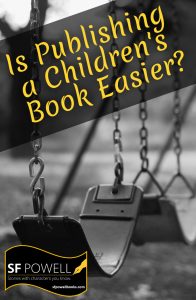Publishing a Children’s Book—Easier Said than Done
 The ‘New Normal’ (as people are calling it) has parents and caretakers of children pursuing many an indoor entertainment options for their wards. Computer games and videos have their place, but a good book is timeless. When it comes to children, first we read to them (rereading five or six times if the story’s a favorite), then they begin learning to read for themselves—and (hopefully) the magic begins.
The ‘New Normal’ (as people are calling it) has parents and caretakers of children pursuing many an indoor entertainment options for their wards. Computer games and videos have their place, but a good book is timeless. When it comes to children, first we read to them (rereading five or six times if the story’s a favorite), then they begin learning to read for themselves—and (hopefully) the magic begins.
For writers wanting to delve into the children’s genre, the demand is there. There is always the wait for the next favorite and engaging children’s character, the next bestselling YA hero or heroine. Many assume books for the 15-and-under audience are easier to get published (as well as an easier way to make more money), but how true is that?
Supply but no demand? Maybe.
Before determining writing and publishing a children’s book is a sure thing, examine the current market. Unlike traditional books for adults, children’s books can be found ‘everywhere,’ from bookstores to dollar stores and discount stores. Parents want their children educated but spend a limited amount on children’s books (thus shopping the dollar/discount stores). The large selection of children’s books at discount stores may impact getting a children’s book published with profitable success.
Competition for children’s books is fierce. As such, many traditional publishers proceed with caution, and self-published books have a rough hill to climb. What makes a $15 children’s book a bestseller for young readers or early adults? A well-known author or a captivating story. It’s why many mainline publishers stay with the same authors or only use agents. But don’t be discouraged. Many up-and-coming publishers are willing to chance a new children’s book author; the key is finding those publishers.
A Children’s Book? Rumor has it …
Authors often write to their interests, but one reason authors produce children’s books (and believe they’re easier to publish) is because of their length. The wordcount for children’s books targeted for toddlers and preschoolers usually tops at a few hundred words. Accordingly, young adult (YA) books targeted at preteens and teens have a much higher wordcount. So, while writing a hundred words assuredly takes less time than writing a couple thousand, quick turnaround doesn’t guarantee publishing success. It may even be harder: using less words requires authors to find the ‘perfect’ ones.
Another reason hopeful authors choose to write children’s books: they believe it’s a better opportunity for making more money. Truth is (given possibility of a minor variance), authors usually receive higher pay for novels and other longer books. Writing a children’s book is quicker, so, an author may be able to write more of them, but time and thought should go into all works, regardless of length or genre. Lastly, it may be easier to produce more children’s books in a shorter time—but they must first be published to earn a profit from them.
Exploring Options
Having decided to publish a children’s book, it’s important not to limit yourself. When it comes to children’s books, most initially think: picture books and board books. These books are popular, but the children’s genre is huge. There are books for beginning readers (small chapter books), as well as more involved stories for young adults. You may want to experiment to determine which type of book feeds the author in you.
Clearly, writing and publishing a children’s book isn’t necessarily easier, but that’s okay. Don’t focus on the ease and/or potential profitability. If the desire and urge to write a book for children is in you, keep your focus there. Write what you know or love. With genuine passion behind your words/stories, some form of success will follow.
Until next time, stay serif, stay safe/well, and read on (a children’s book might do you good).

